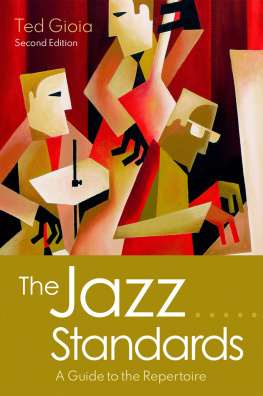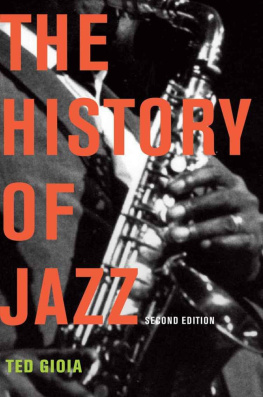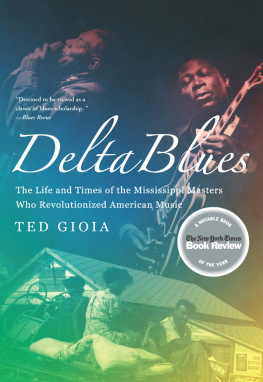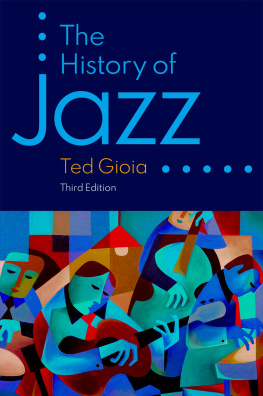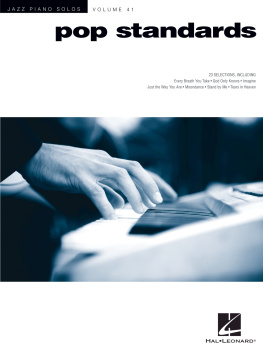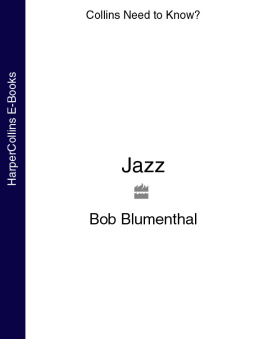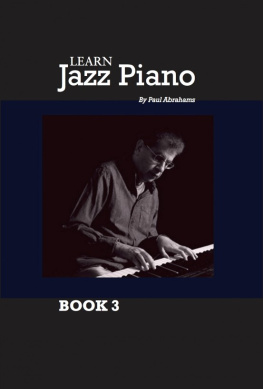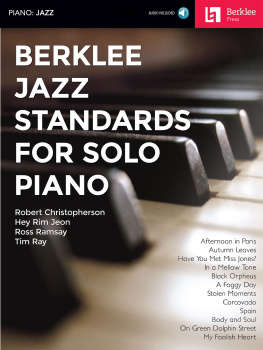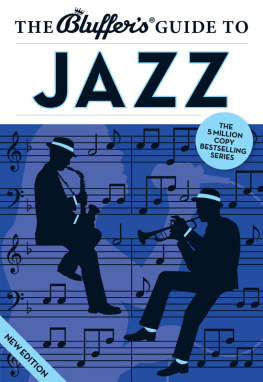THE JAZZ STANDARDS
ALSO BY TED GIOIA
The Imperfect Art: Reflections on Jazz and Modern Culture
West Coast Jazz: Modern Jazz in California 19451960
The History of Jazz
Work Songs
Healing Songs
Delta Blues
The Birth (and Death) of the Cool
Love Songs: The Hidden History
How to Listen to Jazz
Music: A Subversive History

Oxford University Press is a department of the University of Oxford. It furthers the Universitys objective of excellence in research, scholarship, and education by publishing worldwide. Oxford is a registered trade mark of Oxford University Press in the UK and certain other countries.
Published in the United States of America by Oxford University Press
198 Madison Avenue, New York, NY 10016, United States of America.
Ted Gioia 2012, 2021
All rights reserved. No part of this publication may be reproduced, stored in a retrieval system, or transmitted, in any form or by any means, without the prior permission in writing of Oxford University Press, or as expressly permitted by law, by license, or under terms agreed with the appropriate reproduction rights organization. Inquiries concerning reproduction outside the scope of the above should be sent to the Rights Department, Oxford University Press, at the address above.
You must not circulate this work in any other form and you must impose this same condition on any acquirer.
Library of Congress Cataloging-in-Publication Data
Names: Gioia, Ted, author.
Title: The jazz standards : a guide to the repertoire / Ted Gioia.
Description: Second edition. | New York : Oxford University Press, 2021. |
Includes bibliographical references and index.
Identifiers: LCCN 2021008074 (print) | LCCN 2021008075 (ebook) |
ISBN 9780190087173 (hardcover) | ISBN 9780190087203 (epub) |
ISBN 9780190087197 (pdf)
Subjects: LCSH: JazzBibliography. | JazzDiscography. |
JazzAnalysis, appreciation.
Classification: LCC ML128.J3 G56 2021 (print) |
LCC ML128.J3 (ebook) | DDC 016.78165dc23
LC record available at https://lccn.loc.gov/2021008074
LC ebook record available at https://lccn.loc.gov/2021008075
DOI: 10.1093/actrade/9780190087173.001.0001
For my siblings: Dana, Greg and Cara
Contents
I have been learning about these songs for most of my life and could never list the many people who helped shape my understanding of the jazz repertoire. But a handful of individuals gave me valuable advice and input during the actual course of writing this work, and I want to thank them by name. During the preparation of the first edition of this book, I greatly benefited from the contributions of Duck Baker, Kenny Berger, Uri Caine, Breaux Castleman, Paul Combs, Thomas Cunniffe, Ronan Guilfoyle, John Edward Hasse, Ethan Iverson, Todd Jenkins, Bill Kirchner, David McGee, John McNeil, Stuart Nicholson, Lewis Porter, Ricky Riccardi, Jeff Sultanof, Terry Teachout, Scott Timberg, Rob van der Bliek, and Carl Woideck. I benefited from the input of many others as I worked on the second edition, including John Altman, Hctor Balbis, Paul Bordoni, Loudon Briggs, Noah Christopher, Mario Erre, Nenette Evans, Nicola Ferrauto, Don Frese, Mike Galan, Luke Gillespie, Rick Howe, Lucille Hunt, Eric Jackson, Mike Longo, Francesco Martinelli, Joe Medjuck, Kevin Moore, Fred Rosenthal, Eric Rumsey, Michael Sedor, Peter Sokolowski, Alexander Stakenburg, Mark Stryker, Ron Weinstock, and Sandy Williams. If I have left out any names here, I offer apologiesmany have reached out to me with information about these songs over the years, and my gratitude to all of you runs deep.
I am also deeply indebted to Suzanne Ryan and Norm Hirschy at Oxford University Press, as well as Joellyn Ausanka, Caelyn Cobb, Sean Decker, Tim DeWerff, and Woody Gilmartin. Without their advocacy, guidance, and assistance this book would not have been possible. Finally, I offer public thanks to my wife, Tara, and our two sons, Michael and Thomas, for their love and support.
Note
Each entry here is accompanied by a list of recommended recordings. I have made these selections on the basis of their historical importance, influence on later artists, inherent quality, and originality of conception. At the same time, I also tried to highlight a range of interpretive styles. Most of the listed tracks are from the jazz idiom, but I have occasionally included a performance from outside the jazz world if I felt it was relevant to the discussion. For tracks recorded after the early 1950s, I have typically provided the name of an album on which the music can be found. The earlier tracks, predating the era of long-playing albums, are often available on a wide range of reissues and compilations, with varying degrees of availability and accessibilityfor these, I have simply listed a date and location for the recording. In a few instances, I list the track under the name of the best-known artist rather than the original bandleader, since this reflects how these works are typically packaged and distributed.
THE JAZZ STANDARDS
When I was learning how to play jazz during my teenage years, I kept encountering songs that the older musicians expected me to know. I eventually realized that there were around 200 or 300 of these compositions, and that they served as the cornerstone of the jazz repertoire. A jazz performer needed to learn these songs the same way a classical musician studied the works of Bach, Beethoven, and Mozart.
In fact, I soon learned that knowledge of the repertoire was even more important for a jazz musician than for a classical artist. The classical performer at least knows what compositions will be played before the concert begins. This is not always the case with jazz. I recall the lament of a friend who was enlisted to back up a poll-winning horn player at a jazz festivalonly to discover that he wouldnt be told what songs would be played until the musicians were already on stage in front of 6,000 people. Such instances are not unusual in the jazz world, a quirk of a subculture that prizes both spontaneity and macho bravado, perhaps to an excessive degree. Another buddy, a quite talented pianist, encountered an even more uncooperative bandleadera famous saxophonist who wouldnt identify the names of the songs even after the musicians were on the bandstand. The leader would simply play a short introduction on the tenor, than stamp off the beat with his foot... and my friend was expected to figure out the song and key from those meager clues. For better or worse, such is our art form.
I had my own embarrassing situations with unfamiliar standards during my youthbut fortunately never with thousands of people on hand to watch. I soon realized what countless other jazz musicians have no doubt also learned: in-depth study of the jazz repertoire is hardly a quaint historical sideline, but essential for survival. Not learning these songs puts a jazz player on a quick path to unemployment.
But no one gave you a list. Nor would a typical youngster of my (or a later) generation encounter many of these songs outside the jazz worldmost of them had been composed before I was born, and even the more recent entries in the repertoire werent part of the fare you typically heard on TV or mainstream radio. Some of these tunes came from Broadway, but not always from the hit productionsmany first appeared in obscure or failed shows, or revues by relatively unknown songwriters. Others made their debut in movies, or came from big bands, or were introduced by pop singers from outside the jazz world. A fewsuch as Autumn Leaves or Desafinadooriginated far away from jazzs land of origin. And, of course, many were written by jazz musicians themselves, serving as part of the legacy of Miles Davis, Thelonious Monk, Duke Ellington, John Coltrane, Charlie Parker, and other seminal artists.

